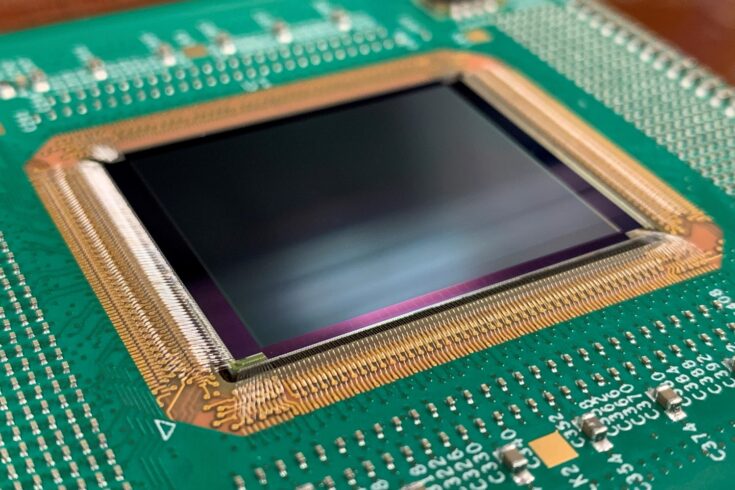Truly high-speed imaging is not found in sports photography or filming explosions for blockbuster movies but in the world of materials and biological science where it is important for researchers to understand how chemical and biological reactions happen in real time.
To do this you need an incredibly rapid imaging system, not 24 frames per second (fps) like an old movie camera but millions of frames a second where you can see objects deforming under stress or reactions taking place in cells. Bringing us to the development of the Kirana module.
The Kirana module
In 2008, Specialised Imaging Limited (SI), an internationally renowned company known for its ultra-high-speed imaging cameras, approached the Science and Technology Facilities Council’s (STFC) Rutherford Appleton Laboratory (RAL) Technology Department to develop sensors that could capture images at five million fps.
Dubbed the ‘Kirana Project’, STFC’s RAL Technology Department have successfully delivered the 150th Kirana module of the five million fps single sensor after returning its first commercial module to SI in 2013.
The Kirana modules have two main applications. First, it is used in materials science to observe the propagation of cracks stress testing, for example, to ensure a bridge is robust enough to hold weight. The second is its military applications, observing munitions either travelling or impacting a surface.
The Kirana modules have become a mainstay in SI’s sensor line-up, achieving the Queen’s Award for Innovation in 2016. The modules have seen much improvement through the years; the latest version now reaching seven million fps in 2021.
Wai Chan, Managing Director of SI, says:
Specialised Imaging identified a gap in the high-speed camera market and set about finding a solution to provide very high-resolution images at megahertz rates.
The technology did not exist at the time, and further research led us to the CMOS Image Sensor group at the Science and Technology Facilities Council’s (STFC) Technology Department who were well positioned to develop the new technology required to meet this challenging marketing requirement.
Our expertise
The STFC RAL Technology Department have a specialised group in CMOS Sensor Design, appropriately named the CMOS Sensor Design Group (CSDG). The CSDG led on the Kirana Project and were assisted by other groups within the department.
Alongside the CSDG, RAL Tech’s Drawing Office designed the printed circuit boards (PCB). The Interconnect Group handled the assembly of the modules, and the Cryogenics Team supported early design in the mechanical housing of the module.
Marcus French, Head of Technology’s Detector and Electronics Division, says:
The challenges posed by our science applications often lead to skills that have ‘spin-out’ applications in industry.
Here, our experience with high-speed imaging for science perfectly matched the gap that Specialised Imaging were seeking to fill in the commercial camera market.
Combining our skills with their market knowledge a world-leading product was rapidly developed that still dominates the market at this speed and we have been delighted to support them by delivering their imager assemblies ever since.
A fancy queuing system
The Kirana module has 924 times 768 pixels capable of recording light by converting it into packets of charge in the form of electrons in its diode.
The module operates like a queueing system. Each pixel of an image has a set of memory cells called charge-coupled devices (CCD). These cells act as storage spaces where each picture frame is kept.
When an image is captured, a little bit of light goes into the camera and creates a tiny electrical charge in the system’s diode, called a ‘charge packet’.
This charge packet moves into an area called the vertical entry register, which shuffles any previous frames along. It fills up quickly, only being able to hold 10 charge packets. Once 10 charge packets have been accumulated, they move along to the lateral register. The lateral register helps organise the charge packets so that the camera can read them properly.
Once this process has completed 16 times, the charge reaches the vertical exit register, where the camera’s readout system takes over and sends the picture data to external electronics in the camera.
Solving memory problems
The CCD cells found in more commercial and accessible cameras are no different than the ones used for Kirana’s memory, which poses a challenge. The Kirana modules capture up to five million fps, so it can be incredibly difficult for the CCD to keep up!
To solve this problem, the camera uses special barriers at the top and bottom of each pixel to block out any extra light that enters and stopping any charge that’s being generated from underneath the instrument.
Once the camera has captured all the information it needs, the picture is stored in the camera’s memory and can be read at the leisurely pace of 10,000 fps, which is still astronomically quick for a standard camera!
Capturing light
To capture images, the light enters the chip and creates electrons that move to the diode for the queueing system process above to capture. The longer the wavelength, the deeper the electrons go into the chip.
Shorter blue wavelengths will go about as far as 2 micrometres(µm) and longer red wavelengths will travel up to 8µm. The ability to capture as much light as possible is vital, otherwise, you may end up with a camera that can only see red objects, so the design parameters need to be optimised to allow this.
Wai Chan finishes by concluding:
After three years of very close collaboration, the completed design provided an innovative image sensor which was broadly welcomed by our customers worldwide and has helped Specialised Imaging cement its position as a world leader in ultra-high-speed imaging.
The close collaboration with STFC continues today, and Specialised Imaging has found that the depth and breadth of knowledge and skills available within the various groups at STFC have been invaluable in helping us to maintain our market position and continue to improve this flagship product.



